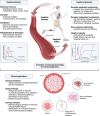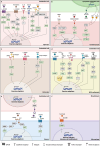Molecular insights of exercise therapy in disease prevention and treatment
- PMID: 38806473
- PMCID: PMC11133400
- DOI: 10.1038/s41392-024-01841-0
Molecular insights of exercise therapy in disease prevention and treatment
Abstract
Despite substantial evidence emphasizing the pleiotropic benefits of exercise for the prevention and treatment of various diseases, the underlying biological mechanisms have not been fully elucidated. Several exercise benefits have been attributed to signaling molecules that are released in response to exercise by different tissues such as skeletal muscle, cardiac muscle, adipose, and liver tissue. These signaling molecules, which are collectively termed exerkines, form a heterogenous group of bioactive substances, mediating inter-organ crosstalk as well as structural and functional tissue adaption. Numerous scientific endeavors have focused on identifying and characterizing new biological mediators with such properties. Additionally, some investigations have focused on the molecular targets of exerkines and the cellular signaling cascades that trigger adaption processes. A detailed understanding of the tissue-specific downstream effects of exerkines is crucial to harness the health-related benefits mediated by exercise and improve targeted exercise programs in health and disease. Herein, we review the current in vivo evidence on exerkine-induced signal transduction across multiple target tissues and highlight the preventive and therapeutic value of exerkine signaling in various diseases. By emphasizing different aspects of exerkine research, we provide a comprehensive overview of (i) the molecular underpinnings of exerkine secretion, (ii) the receptor-dependent and receptor-independent signaling cascades mediating tissue adaption, and (iii) the clinical implications of these mechanisms in disease prevention and treatment.
© 2024. The Author(s).
Conflict of interest statement
The authors declare no competing interests.
Figures





Similar articles
-
Falls prevention interventions for community-dwelling older adults: systematic review and meta-analysis of benefits, harms, and patient values and preferences.Syst Rev. 2024 Nov 26;13(1):289. doi: 10.1186/s13643-024-02681-3. Syst Rev. 2024. PMID: 39593159 Free PMC article.
-
The Black Book of Psychotropic Dosing and Monitoring.Psychopharmacol Bull. 2024 Jul 8;54(3):8-59. Psychopharmacol Bull. 2024. PMID: 38993656 Free PMC article. Review.
-
Interventions for promoting habitual exercise in people living with and beyond cancer.Cochrane Database Syst Rev. 2018 Sep 19;9(9):CD010192. doi: 10.1002/14651858.CD010192.pub3. Cochrane Database Syst Rev. 2018. PMID: 30229557 Free PMC article.
-
NIH Consensus Statement on Management of Hepatitis C: 2002.NIH Consens State Sci Statements. 2002 Jun 10-12;19(3):1-46. NIH Consens State Sci Statements. 2002. PMID: 14768714
-
Systemic pharmacological treatments for chronic plaque psoriasis: a network meta-analysis.Cochrane Database Syst Rev. 2021 Apr 19;4(4):CD011535. doi: 10.1002/14651858.CD011535.pub4. Cochrane Database Syst Rev. 2021. Update in: Cochrane Database Syst Rev. 2022 May 23;5:CD011535. doi: 10.1002/14651858.CD011535.pub5. PMID: 33871055 Free PMC article. Updated.
Cited by
-
Role and Functions of Irisin: A Perspective on Recent Developments and Neurodegenerative Diseases.Antioxidants (Basel). 2025 May 7;14(5):554. doi: 10.3390/antiox14050554. Antioxidants (Basel). 2025. PMID: 40427436 Free PMC article. Review.
-
Molecular Mechanisms and Clinical Implications of Complex Prehabilitation in Colorectal Cancer Surgery: A Comprehensive Review.Int J Mol Sci. 2025 Jul 26;26(15):7242. doi: 10.3390/ijms26157242. Int J Mol Sci. 2025. PMID: 40806373 Free PMC article. Review.
-
New perspectives on molecular mechanisms underlying exercise-induced benefits in Parkinson's disease.NPJ Parkinsons Dis. 2025 Aug 23;11(1):256. doi: 10.1038/s41531-025-01113-w. NPJ Parkinsons Dis. 2025. PMID: 40849310 Free PMC article. Review.
-
Harnessing exercise to combat chronic diseases: the role of Drp1-Mediated mitochondrial fission.Front Cell Dev Biol. 2025 Feb 26;13:1481756. doi: 10.3389/fcell.2025.1481756. eCollection 2025. Front Cell Dev Biol. 2025. PMID: 40078364 Free PMC article. Review.
-
The effect of physical activity on markers of oxidative and antioxidant stress in cancer patients: a systematic review and meta-analysis.BMC Cancer. 2025 Jan 13;25(1):74. doi: 10.1186/s12885-024-13099-4. BMC Cancer. 2025. PMID: 39806299 Free PMC article.
References
-
- Knight, J. A. Physical inactivity: associated diseases and disorders. Ann. Clin. Lab. Sci.42, 320–337 (2012). - PubMed
Publication types
MeSH terms
LinkOut - more resources
Full Text Sources

